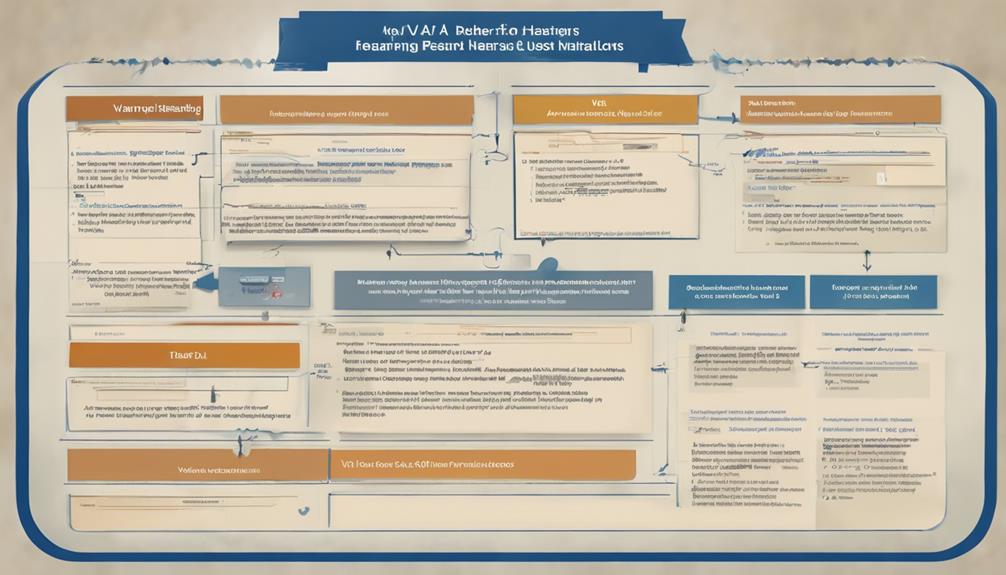As we delve into the intricate realm of veterans’ benefits and the resources accessible to individuals facing hearing loss, the VA Hearing Loss Chart emerges as a valuable tool in navigating the bewildering landscape. Through its systematic approach and thorough information, it serves as a helpful resource for understanding the evaluation procedures, application techniques, and potential benefits for individuals managing hearing impairments.
But what lies beyond the surface of this step-by-step guide? Stay tuned to uncover practical insights and strategies for optimizing support and resources for veterans grappling with hearing loss within the realm of VA assistance.
Key Takeaways
- Understand VA Hearing Loss Chart for disability ratings and compensation.
- Decode audiogram results to determine severity and treatment options.
- Determine Disability Rating based on pure-tone thresholds and impact on daily life.
- Apply for VA Benefits with comprehensive documentation and expert assistance.
Understanding VA Hearing Loss Chart
Understanding the VA Hearing Loss Chart requires a thorough grasp of the specific criteria and thresholds used to determine disability ratings for hearing loss. The VA Hearing Loss Chart outlines disability ratings ranging from 0% to 100%, with puretone thresholds and speech discrimination test results serving as key factors in this assessment.
By evaluating these measures, VA officials can gauge the severity of hearing loss and its impact on daily functioning. Veterans need to meet certain thresholds on the chart to qualify for different disability ratings, especially when seeking compensation for service-connected hearing loss.
This chart is crucial for veterans navigating the complexities of disability claims related to hearing loss, as it provides a structured framework for understanding the level of impairment and the corresponding compensation they may be entitled to based on their condition. By comprehending the VA Hearing Loss Chart, veterans can better advocate for themselves and access the support they need.
Deciphering Audiogram Results

Navigating the VA Hearing Loss Chart successfully involves interpreting audiogram results to determine the type and severity of hearing loss based on the softest sounds a person can hear at different frequencies. Audiogram results display thresholds of hearing for each ear, with the x-axis representing frequencies and the y-axis indicating intensity. By understanding the pattern of audiogram results, healthcare providers can identify the severity and type of hearing loss, which is crucial for recommending appropriate treatment options and interventions.
| Frequency (Hz) | Intensity (dB HL) |
|---|---|
| 250 | 25 |
| 500 | 30 |
| 1000 | 40 |
Analyzing audiogram results involves looking at the thresholds at various frequencies to create a comprehensive picture of an individual's hearing abilities. This data helps professionals tailor interventions to address specific areas of hearing loss effectively. By grasping the nuances of audiogram results, healthcare providers can offer personalized care for individuals experiencing hearing difficulties.
Determining Disability Rating
In determining the disability rating for hearing loss, the VA utilizes a rating schedule that considers the severity of the impairment and its impact on daily life. The VA assigns disability ratings ranging from 0% to 100% for hearing loss, with higher ratings reflecting more severe impairment.
These ratings are pivotal in determining the level of VA disability compensation and benefits that service members may receive for their hearing loss. Factors such as pure-tone thresholds and results from speech discrimination tests play a crucial role in the assessment process.
The severity of the hearing loss and its effects on daily functioning are carefully evaluated to establish an appropriate compensation level. Moreover, establishing a medical nexus between a veteran's hearing loss and their military service is essential for a successful disability claim.
Understanding the VA's rating system for hearing loss is vital for veterans seeking compensation for the impacts of their service-related hearing impairments.
Applying for VA Benefits

When seeking VA benefits for hearing loss, assembling all pertinent medical records and supporting documentation is crucial to bolster your claim. To apply for VA benefits, you can submit your application online, in person, or by mail, ensuring you provide detailed information about your military service and how your hearing loss impacts your daily life.
Including supporting evidence, such as statements from family members or coworkers, can strengthen your application for VA benefits. After submitting your application, a VA representative will review it, schedule an exam to assess your eligibility for hearing loss benefits based on the provided information.
Working with a qualified VA representative or attorney can help ensure a successful application for VA hearing loss benefits. Remember that thorough documentation and collaboration with experts can significantly increase your chances of a favorable outcome when applying for VA benefits related to hearing loss.
Maximizing VA Hearing Loss Benefits
To enhance your chances of maximizing VA hearing loss benefits, it's essential to provide accurate information and supporting evidence to strengthen your claim. When seeking VA benefits for hearing loss, it's crucial to follow recommended treatment plans and submit additional evidence to support your VA disability claim.
Working with a qualified VA representative or attorney can significantly increase the likelihood of a successful application. If you believe you deserve a higher VA rating due to worsening hearing loss, filing an appeal is a valid course of action to maximize VA benefits.
Documenting the impact of hearing loss on your daily activities and relationships is vital to support your claim for additional compensation. Remember, thorough documentation, adherence to treatment plans, and seeking professional guidance are key steps in maximizing VA benefits for hearing loss.
Veterans deserve the best possible support for their service-related disabilities, including those affecting the inner ear and causing tinnitus.
Frequently Asked Questions
How Does the VA Calculate Hearing Loss?
We calculate hearing loss by analyzing results from speech discrimination and puretone audiometry tests. Speech discrimination measures understanding speech in noisy settings, while puretone audiometry evaluates hearing sensitivity at various frequencies.
These results help us determine the severity of hearing loss and assign a disability rating ranging from 0% to 100% based on the level of impairment.
How Do You Win a Hearing Loss at the Va?
Winning a hearing loss claim at the VA involves proving a connection between your military service and current diagnosis.
We must establish a clear link to the in-service event causing the hearing loss. A medical opinion connecting these dots is crucial for VA benefits.
Submitting specific tests like the Maryland CNC Test and Puretone Audiometric Test supports your claim.
Being honest during VA examinations about the impact and timeline of your hearing loss is essential.
What Is the VA C&P Exam for Hearing Loss?
We undergo the VA C&P exam for hearing loss to evaluate our disability. This assessment includes tests like speech discrimination and puretone audiometry, conducted without hearing aids.
The results determine our disability rating for benefits. This exam is crucial for the VA to understand the severity of our hearing loss and how it affects our daily life. It's a key step in the process of applying for and receiving hearing loss benefits.
What Is the Configuration of Hearing Loss?
We understand that hearing loss configuration refers to the pattern and extent of hearing loss across different frequencies. Common configurations include flat, sloping, rising, and cookie-bite patterns.
The flat configuration involves similar levels of hearing loss across frequencies, while the sloping configuration indicates more severe hearing loss at higher frequencies. These configurations impact speech understanding and communication abilities differently, highlighting the importance of understanding one's specific hearing loss configuration.
Conclusion
As we navigate the intricate path of VA benefits for hearing loss, let's remember that each step taken is a note in the symphony of support for our veterans.
Like a conductor guiding an orchestra, let's strive to harmonize our efforts in maximizing benefits and advocating for those who've served.
Together, we can create a melody of care and recognition for those who've sacrificed for our freedom.











